SWOT Analysis and Leadership Styles
VerifiedAdded on 2020/11/12
|10
|3211
|224
AI Summary
The report conducts a thorough SWOT analysis of Hazev, Has, and Tas restaurant, identifying its strengths in digital technological tools adoption and consensual leadership style. However, it also highlights weaknesses such as ineffective waste treatment practices that may result in lower income and competitive advantage decline. The report further discusses the impact of digital technology on the restaurant's operations and management, concluding that changes have been made to overcome resistance to change.
Contribute Materials
Your contribution can guide someone’s learning journey. Share your
documents today.
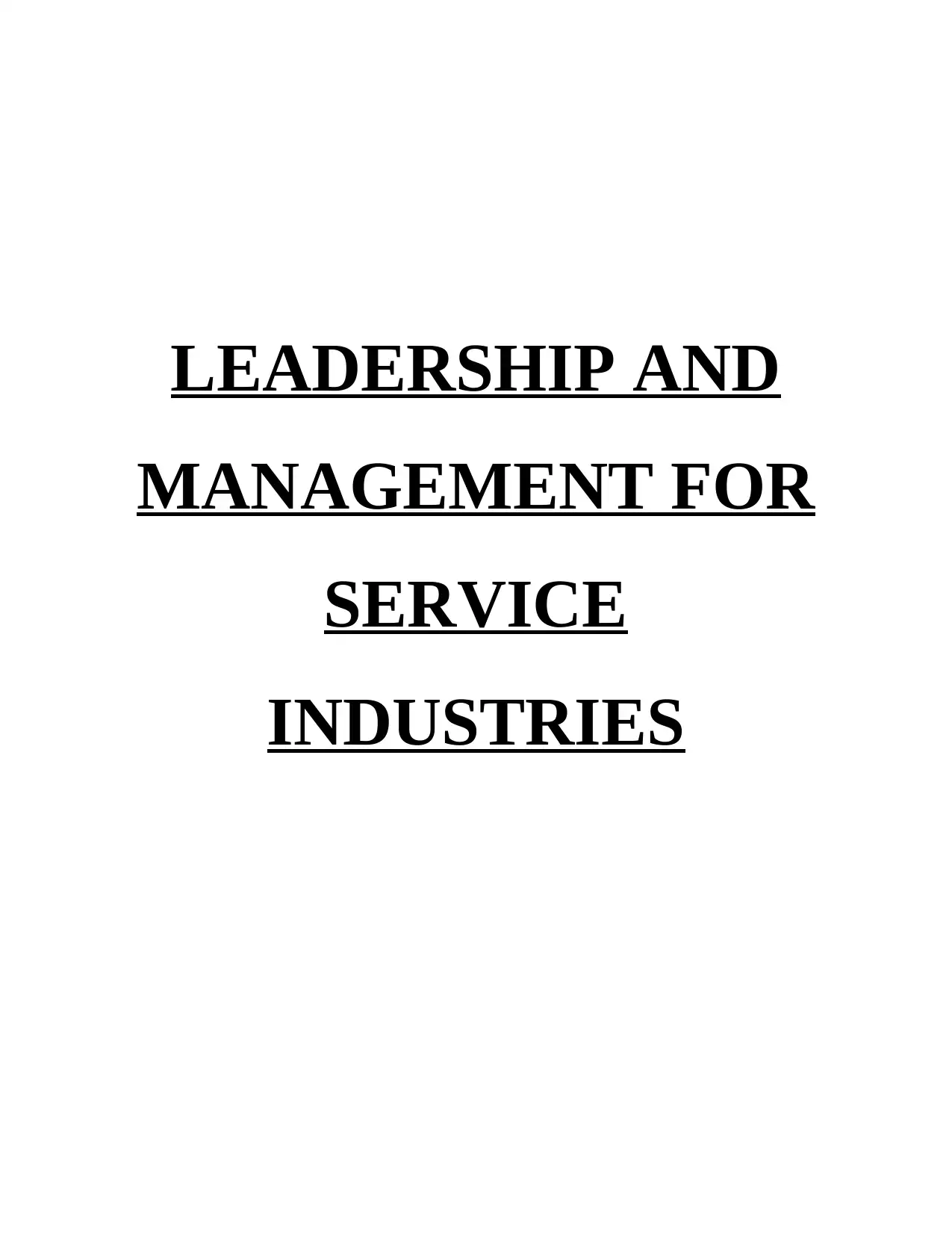
LEADERSHIP AND
MANAGEMENT FOR
SERVICE
INDUSTRIES
MANAGEMENT FOR
SERVICE
INDUSTRIES
Secure Best Marks with AI Grader
Need help grading? Try our AI Grader for instant feedback on your assignments.
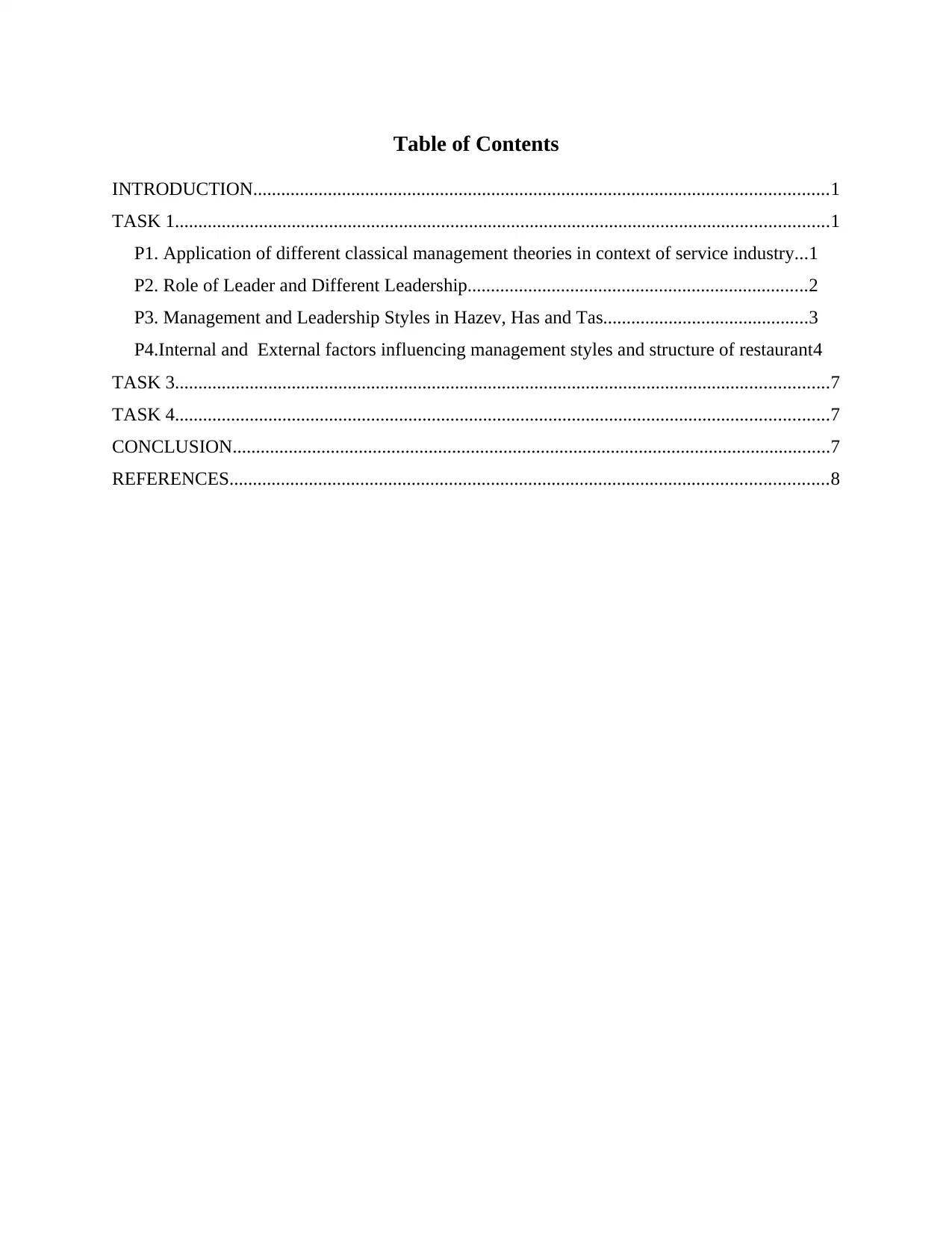
Table of Contents
INTRODUCTION...........................................................................................................................1
TASK 1............................................................................................................................................1
P1. Application of different classical management theories in context of service industry...1
P2. Role of Leader and Different Leadership.........................................................................2
P3. Management and Leadership Styles in Hazev, Has and Tas............................................3
P4.Internal and External factors influencing management styles and structure of restaurant4
TASK 3............................................................................................................................................7
TASK 4............................................................................................................................................7
CONCLUSION................................................................................................................................7
REFERENCES................................................................................................................................8
INTRODUCTION...........................................................................................................................1
TASK 1............................................................................................................................................1
P1. Application of different classical management theories in context of service industry...1
P2. Role of Leader and Different Leadership.........................................................................2
P3. Management and Leadership Styles in Hazev, Has and Tas............................................3
P4.Internal and External factors influencing management styles and structure of restaurant4
TASK 3............................................................................................................................................7
TASK 4............................................................................................................................................7
CONCLUSION................................................................................................................................7
REFERENCES................................................................................................................................8
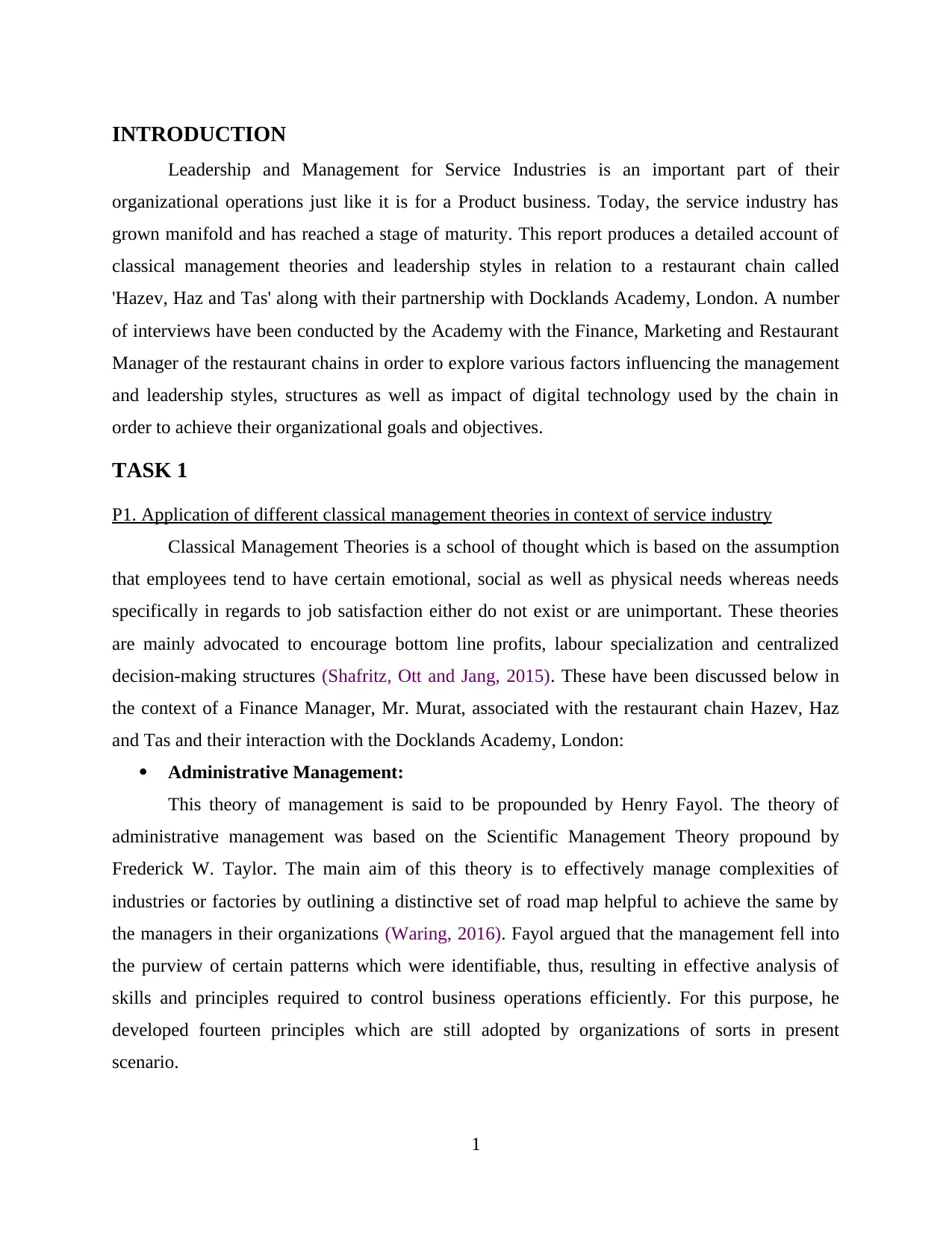
INTRODUCTION
Leadership and Management for Service Industries is an important part of their
organizational operations just like it is for a Product business. Today, the service industry has
grown manifold and has reached a stage of maturity. This report produces a detailed account of
classical management theories and leadership styles in relation to a restaurant chain called
'Hazev, Haz and Tas' along with their partnership with Docklands Academy, London. A number
of interviews have been conducted by the Academy with the Finance, Marketing and Restaurant
Manager of the restaurant chains in order to explore various factors influencing the management
and leadership styles, structures as well as impact of digital technology used by the chain in
order to achieve their organizational goals and objectives.
TASK 1
P1. Application of different classical management theories in context of service industry
Classical Management Theories is a school of thought which is based on the assumption
that employees tend to have certain emotional, social as well as physical needs whereas needs
specifically in regards to job satisfaction either do not exist or are unimportant. These theories
are mainly advocated to encourage bottom line profits, labour specialization and centralized
decision-making structures (Shafritz, Ott and Jang, 2015). These have been discussed below in
the context of a Finance Manager, Mr. Murat, associated with the restaurant chain Hazev, Haz
and Tas and their interaction with the Docklands Academy, London:
Administrative Management:
This theory of management is said to be propounded by Henry Fayol. The theory of
administrative management was based on the Scientific Management Theory propound by
Frederick W. Taylor. The main aim of this theory is to effectively manage complexities of
industries or factories by outlining a distinctive set of road map helpful to achieve the same by
the managers in their organizations (Waring, 2016). Fayol argued that the management fell into
the purview of certain patterns which were identifiable, thus, resulting in effective analysis of
skills and principles required to control business operations efficiently. For this purpose, he
developed fourteen principles which are still adopted by organizations of sorts in present
scenario.
1
Leadership and Management for Service Industries is an important part of their
organizational operations just like it is for a Product business. Today, the service industry has
grown manifold and has reached a stage of maturity. This report produces a detailed account of
classical management theories and leadership styles in relation to a restaurant chain called
'Hazev, Haz and Tas' along with their partnership with Docklands Academy, London. A number
of interviews have been conducted by the Academy with the Finance, Marketing and Restaurant
Manager of the restaurant chains in order to explore various factors influencing the management
and leadership styles, structures as well as impact of digital technology used by the chain in
order to achieve their organizational goals and objectives.
TASK 1
P1. Application of different classical management theories in context of service industry
Classical Management Theories is a school of thought which is based on the assumption
that employees tend to have certain emotional, social as well as physical needs whereas needs
specifically in regards to job satisfaction either do not exist or are unimportant. These theories
are mainly advocated to encourage bottom line profits, labour specialization and centralized
decision-making structures (Shafritz, Ott and Jang, 2015). These have been discussed below in
the context of a Finance Manager, Mr. Murat, associated with the restaurant chain Hazev, Haz
and Tas and their interaction with the Docklands Academy, London:
Administrative Management:
This theory of management is said to be propounded by Henry Fayol. The theory of
administrative management was based on the Scientific Management Theory propound by
Frederick W. Taylor. The main aim of this theory is to effectively manage complexities of
industries or factories by outlining a distinctive set of road map helpful to achieve the same by
the managers in their organizations (Waring, 2016). Fayol argued that the management fell into
the purview of certain patterns which were identifiable, thus, resulting in effective analysis of
skills and principles required to control business operations efficiently. For this purpose, he
developed fourteen principles which are still adopted by organizations of sorts in present
scenario.
1
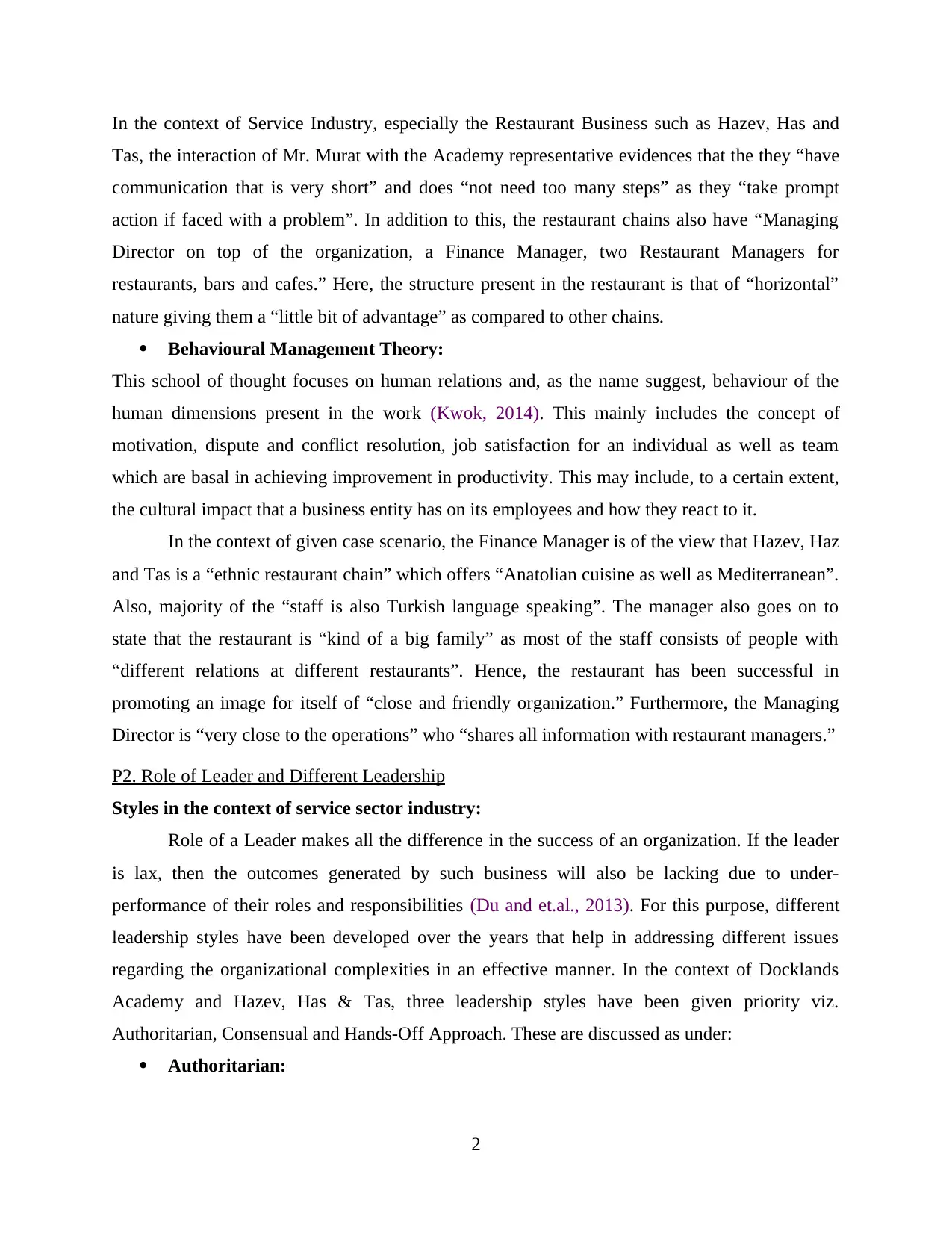
In the context of Service Industry, especially the Restaurant Business such as Hazev, Has and
Tas, the interaction of Mr. Murat with the Academy representative evidences that the they “have
communication that is very short” and does “not need too many steps” as they “take prompt
action if faced with a problem”. In addition to this, the restaurant chains also have “Managing
Director on top of the organization, a Finance Manager, two Restaurant Managers for
restaurants, bars and cafes.” Here, the structure present in the restaurant is that of “horizontal”
nature giving them a “little bit of advantage” as compared to other chains.
Behavioural Management Theory:
This school of thought focuses on human relations and, as the name suggest, behaviour of the
human dimensions present in the work (Kwok, 2014). This mainly includes the concept of
motivation, dispute and conflict resolution, job satisfaction for an individual as well as team
which are basal in achieving improvement in productivity. This may include, to a certain extent,
the cultural impact that a business entity has on its employees and how they react to it.
In the context of given case scenario, the Finance Manager is of the view that Hazev, Haz
and Tas is a “ethnic restaurant chain” which offers “Anatolian cuisine as well as Mediterranean”.
Also, majority of the “staff is also Turkish language speaking”. The manager also goes on to
state that the restaurant is “kind of a big family” as most of the staff consists of people with
“different relations at different restaurants”. Hence, the restaurant has been successful in
promoting an image for itself of “close and friendly organization.” Furthermore, the Managing
Director is “very close to the operations” who “shares all information with restaurant managers.”
P2. Role of Leader and Different Leadership
Styles in the context of service sector industry:
Role of a Leader makes all the difference in the success of an organization. If the leader
is lax, then the outcomes generated by such business will also be lacking due to under-
performance of their roles and responsibilities (Du and et.al., 2013). For this purpose, different
leadership styles have been developed over the years that help in addressing different issues
regarding the organizational complexities in an effective manner. In the context of Docklands
Academy and Hazev, Has & Tas, three leadership styles have been given priority viz.
Authoritarian, Consensual and Hands-Off Approach. These are discussed as under:
Authoritarian:
2
Tas, the interaction of Mr. Murat with the Academy representative evidences that the they “have
communication that is very short” and does “not need too many steps” as they “take prompt
action if faced with a problem”. In addition to this, the restaurant chains also have “Managing
Director on top of the organization, a Finance Manager, two Restaurant Managers for
restaurants, bars and cafes.” Here, the structure present in the restaurant is that of “horizontal”
nature giving them a “little bit of advantage” as compared to other chains.
Behavioural Management Theory:
This school of thought focuses on human relations and, as the name suggest, behaviour of the
human dimensions present in the work (Kwok, 2014). This mainly includes the concept of
motivation, dispute and conflict resolution, job satisfaction for an individual as well as team
which are basal in achieving improvement in productivity. This may include, to a certain extent,
the cultural impact that a business entity has on its employees and how they react to it.
In the context of given case scenario, the Finance Manager is of the view that Hazev, Haz
and Tas is a “ethnic restaurant chain” which offers “Anatolian cuisine as well as Mediterranean”.
Also, majority of the “staff is also Turkish language speaking”. The manager also goes on to
state that the restaurant is “kind of a big family” as most of the staff consists of people with
“different relations at different restaurants”. Hence, the restaurant has been successful in
promoting an image for itself of “close and friendly organization.” Furthermore, the Managing
Director is “very close to the operations” who “shares all information with restaurant managers.”
P2. Role of Leader and Different Leadership
Styles in the context of service sector industry:
Role of a Leader makes all the difference in the success of an organization. If the leader
is lax, then the outcomes generated by such business will also be lacking due to under-
performance of their roles and responsibilities (Du and et.al., 2013). For this purpose, different
leadership styles have been developed over the years that help in addressing different issues
regarding the organizational complexities in an effective manner. In the context of Docklands
Academy and Hazev, Has & Tas, three leadership styles have been given priority viz.
Authoritarian, Consensual and Hands-Off Approach. These are discussed as under:
Authoritarian:
2
Secure Best Marks with AI Grader
Need help grading? Try our AI Grader for instant feedback on your assignments.
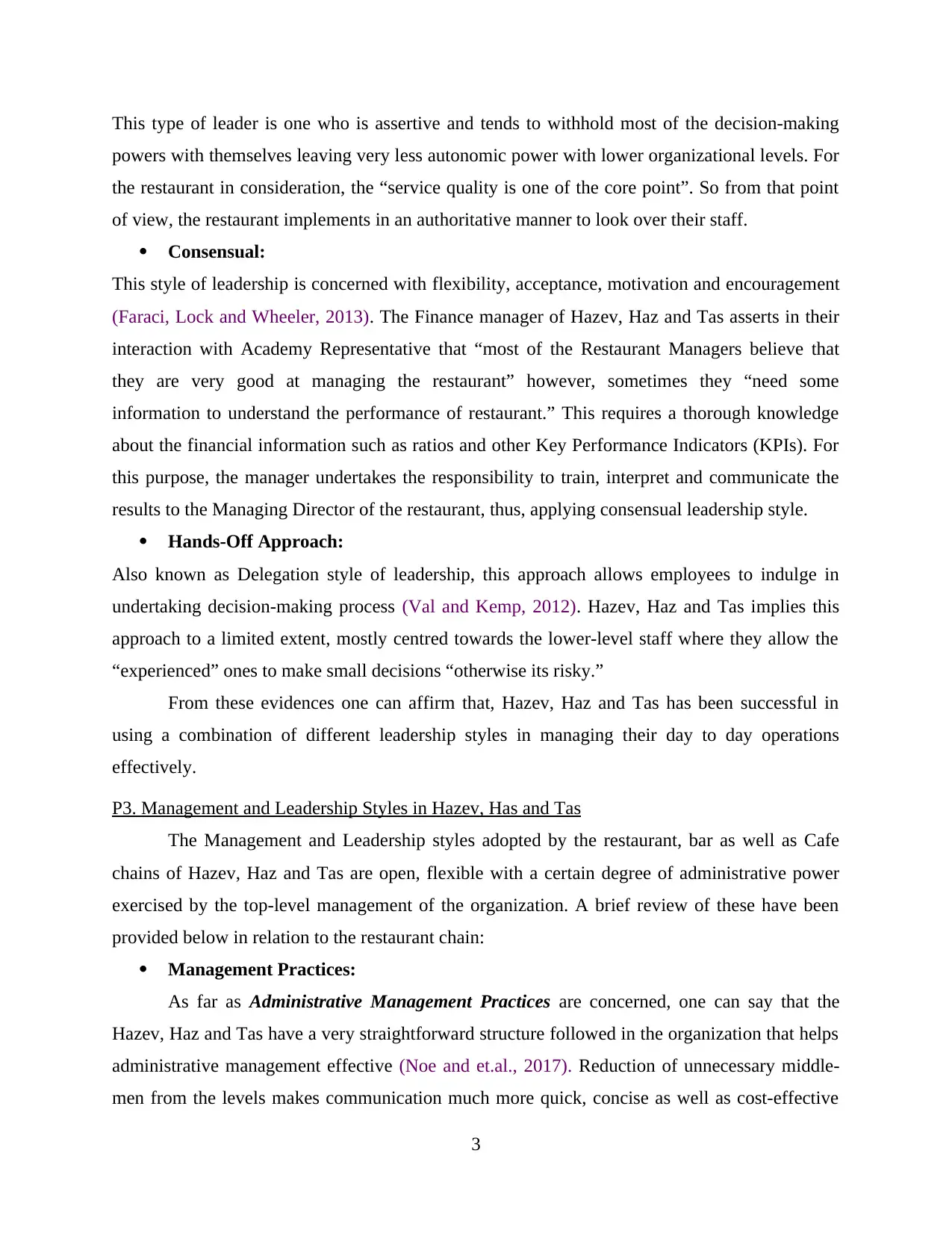
This type of leader is one who is assertive and tends to withhold most of the decision-making
powers with themselves leaving very less autonomic power with lower organizational levels. For
the restaurant in consideration, the “service quality is one of the core point”. So from that point
of view, the restaurant implements in an authoritative manner to look over their staff.
Consensual:
This style of leadership is concerned with flexibility, acceptance, motivation and encouragement
(Faraci, Lock and Wheeler, 2013). The Finance manager of Hazev, Haz and Tas asserts in their
interaction with Academy Representative that “most of the Restaurant Managers believe that
they are very good at managing the restaurant” however, sometimes they “need some
information to understand the performance of restaurant.” This requires a thorough knowledge
about the financial information such as ratios and other Key Performance Indicators (KPIs). For
this purpose, the manager undertakes the responsibility to train, interpret and communicate the
results to the Managing Director of the restaurant, thus, applying consensual leadership style.
Hands-Off Approach:
Also known as Delegation style of leadership, this approach allows employees to indulge in
undertaking decision-making process (Val and Kemp, 2012). Hazev, Haz and Tas implies this
approach to a limited extent, mostly centred towards the lower-level staff where they allow the
“experienced” ones to make small decisions “otherwise its risky.”
From these evidences one can affirm that, Hazev, Haz and Tas has been successful in
using a combination of different leadership styles in managing their day to day operations
effectively.
P3. Management and Leadership Styles in Hazev, Has and Tas
The Management and Leadership styles adopted by the restaurant, bar as well as Cafe
chains of Hazev, Haz and Tas are open, flexible with a certain degree of administrative power
exercised by the top-level management of the organization. A brief review of these have been
provided below in relation to the restaurant chain:
Management Practices:
As far as Administrative Management Practices are concerned, one can say that the
Hazev, Haz and Tas have a very straightforward structure followed in the organization that helps
administrative management effective (Noe and et.al., 2017). Reduction of unnecessary middle-
men from the levels makes communication much more quick, concise as well as cost-effective
3
powers with themselves leaving very less autonomic power with lower organizational levels. For
the restaurant in consideration, the “service quality is one of the core point”. So from that point
of view, the restaurant implements in an authoritative manner to look over their staff.
Consensual:
This style of leadership is concerned with flexibility, acceptance, motivation and encouragement
(Faraci, Lock and Wheeler, 2013). The Finance manager of Hazev, Haz and Tas asserts in their
interaction with Academy Representative that “most of the Restaurant Managers believe that
they are very good at managing the restaurant” however, sometimes they “need some
information to understand the performance of restaurant.” This requires a thorough knowledge
about the financial information such as ratios and other Key Performance Indicators (KPIs). For
this purpose, the manager undertakes the responsibility to train, interpret and communicate the
results to the Managing Director of the restaurant, thus, applying consensual leadership style.
Hands-Off Approach:
Also known as Delegation style of leadership, this approach allows employees to indulge in
undertaking decision-making process (Val and Kemp, 2012). Hazev, Haz and Tas implies this
approach to a limited extent, mostly centred towards the lower-level staff where they allow the
“experienced” ones to make small decisions “otherwise its risky.”
From these evidences one can affirm that, Hazev, Haz and Tas has been successful in
using a combination of different leadership styles in managing their day to day operations
effectively.
P3. Management and Leadership Styles in Hazev, Has and Tas
The Management and Leadership styles adopted by the restaurant, bar as well as Cafe
chains of Hazev, Haz and Tas are open, flexible with a certain degree of administrative power
exercised by the top-level management of the organization. A brief review of these have been
provided below in relation to the restaurant chain:
Management Practices:
As far as Administrative Management Practices are concerned, one can say that the
Hazev, Haz and Tas have a very straightforward structure followed in the organization that helps
administrative management effective (Noe and et.al., 2017). Reduction of unnecessary middle-
men from the levels makes communication much more quick, concise as well as cost-effective
3
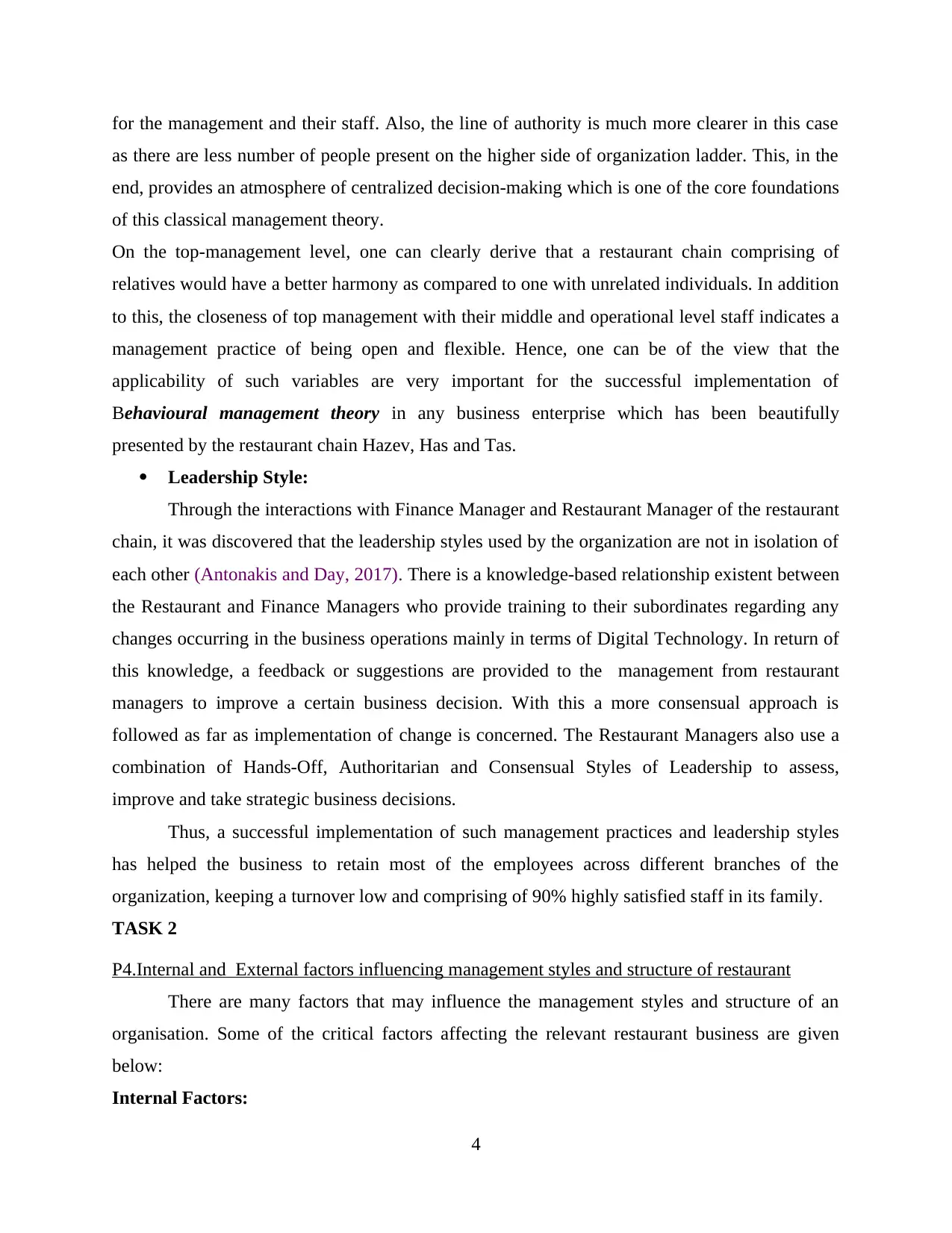
for the management and their staff. Also, the line of authority is much more clearer in this case
as there are less number of people present on the higher side of organization ladder. This, in the
end, provides an atmosphere of centralized decision-making which is one of the core foundations
of this classical management theory.
On the top-management level, one can clearly derive that a restaurant chain comprising of
relatives would have a better harmony as compared to one with unrelated individuals. In addition
to this, the closeness of top management with their middle and operational level staff indicates a
management practice of being open and flexible. Hence, one can be of the view that the
applicability of such variables are very important for the successful implementation of
Behavioural management theory in any business enterprise which has been beautifully
presented by the restaurant chain Hazev, Has and Tas.
Leadership Style:
Through the interactions with Finance Manager and Restaurant Manager of the restaurant
chain, it was discovered that the leadership styles used by the organization are not in isolation of
each other (Antonakis and Day, 2017). There is a knowledge-based relationship existent between
the Restaurant and Finance Managers who provide training to their subordinates regarding any
changes occurring in the business operations mainly in terms of Digital Technology. In return of
this knowledge, a feedback or suggestions are provided to the management from restaurant
managers to improve a certain business decision. With this a more consensual approach is
followed as far as implementation of change is concerned. The Restaurant Managers also use a
combination of Hands-Off, Authoritarian and Consensual Styles of Leadership to assess,
improve and take strategic business decisions.
Thus, a successful implementation of such management practices and leadership styles
has helped the business to retain most of the employees across different branches of the
organization, keeping a turnover low and comprising of 90% highly satisfied staff in its family.
TASK 2
P4.Internal and External factors influencing management styles and structure of restaurant
There are many factors that may influence the management styles and structure of an
organisation. Some of the critical factors affecting the relevant restaurant business are given
below:
Internal Factors:
4
as there are less number of people present on the higher side of organization ladder. This, in the
end, provides an atmosphere of centralized decision-making which is one of the core foundations
of this classical management theory.
On the top-management level, one can clearly derive that a restaurant chain comprising of
relatives would have a better harmony as compared to one with unrelated individuals. In addition
to this, the closeness of top management with their middle and operational level staff indicates a
management practice of being open and flexible. Hence, one can be of the view that the
applicability of such variables are very important for the successful implementation of
Behavioural management theory in any business enterprise which has been beautifully
presented by the restaurant chain Hazev, Has and Tas.
Leadership Style:
Through the interactions with Finance Manager and Restaurant Manager of the restaurant
chain, it was discovered that the leadership styles used by the organization are not in isolation of
each other (Antonakis and Day, 2017). There is a knowledge-based relationship existent between
the Restaurant and Finance Managers who provide training to their subordinates regarding any
changes occurring in the business operations mainly in terms of Digital Technology. In return of
this knowledge, a feedback or suggestions are provided to the management from restaurant
managers to improve a certain business decision. With this a more consensual approach is
followed as far as implementation of change is concerned. The Restaurant Managers also use a
combination of Hands-Off, Authoritarian and Consensual Styles of Leadership to assess,
improve and take strategic business decisions.
Thus, a successful implementation of such management practices and leadership styles
has helped the business to retain most of the employees across different branches of the
organization, keeping a turnover low and comprising of 90% highly satisfied staff in its family.
TASK 2
P4.Internal and External factors influencing management styles and structure of restaurant
There are many factors that may influence the management styles and structure of an
organisation. Some of the critical factors affecting the relevant restaurant business are given
below:
Internal Factors:
4
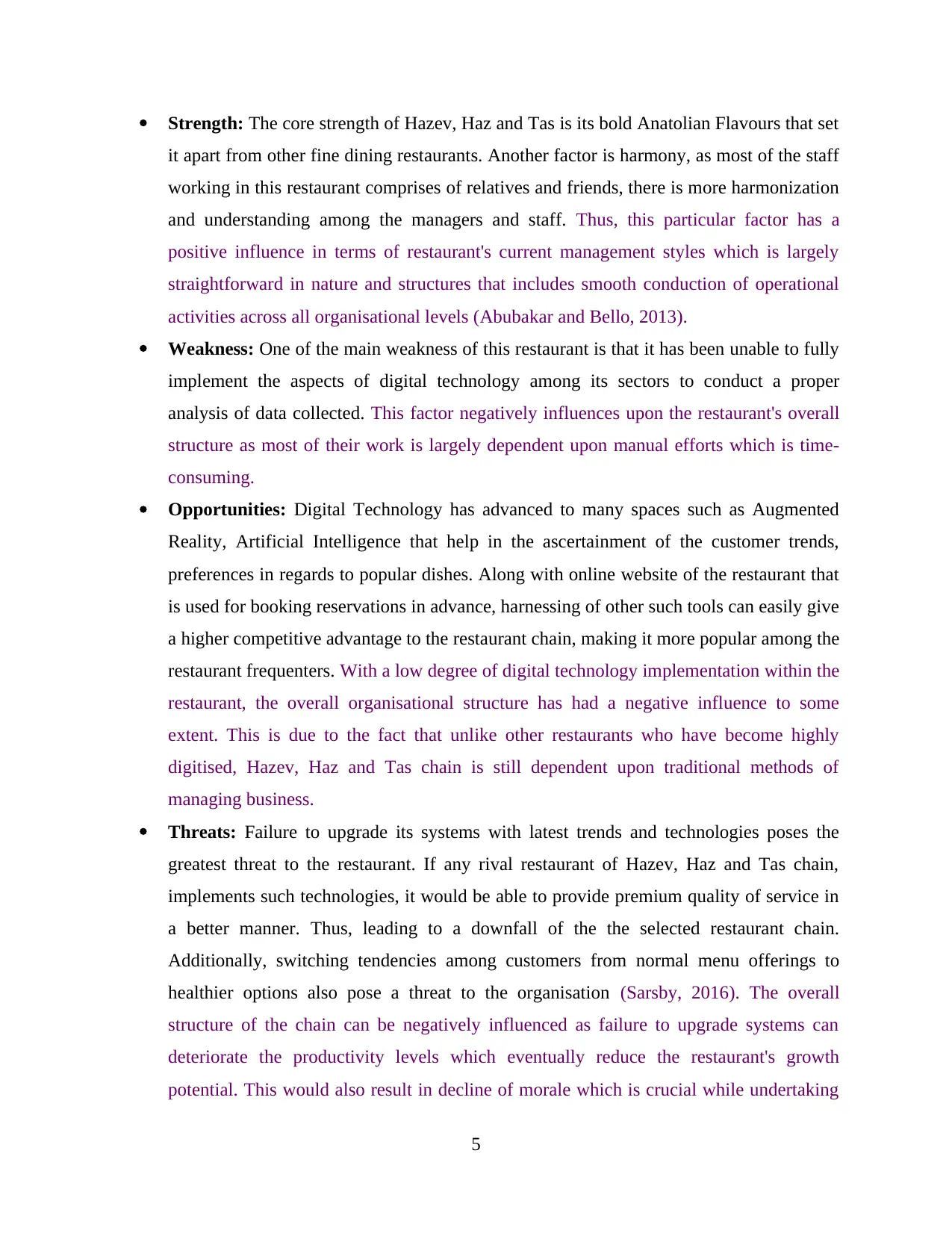
Strength: The core strength of Hazev, Haz and Tas is its bold Anatolian Flavours that set
it apart from other fine dining restaurants. Another factor is harmony, as most of the staff
working in this restaurant comprises of relatives and friends, there is more harmonization
and understanding among the managers and staff. Thus, this particular factor has a
positive influence in terms of restaurant's current management styles which is largely
straightforward in nature and structures that includes smooth conduction of operational
activities across all organisational levels (Abubakar and Bello, 2013).
Weakness: One of the main weakness of this restaurant is that it has been unable to fully
implement the aspects of digital technology among its sectors to conduct a proper
analysis of data collected. This factor negatively influences upon the restaurant's overall
structure as most of their work is largely dependent upon manual efforts which is time-
consuming.
Opportunities: Digital Technology has advanced to many spaces such as Augmented
Reality, Artificial Intelligence that help in the ascertainment of the customer trends,
preferences in regards to popular dishes. Along with online website of the restaurant that
is used for booking reservations in advance, harnessing of other such tools can easily give
a higher competitive advantage to the restaurant chain, making it more popular among the
restaurant frequenters. With a low degree of digital technology implementation within the
restaurant, the overall organisational structure has had a negative influence to some
extent. This is due to the fact that unlike other restaurants who have become highly
digitised, Hazev, Haz and Tas chain is still dependent upon traditional methods of
managing business.
Threats: Failure to upgrade its systems with latest trends and technologies poses the
greatest threat to the restaurant. If any rival restaurant of Hazev, Haz and Tas chain,
implements such technologies, it would be able to provide premium quality of service in
a better manner. Thus, leading to a downfall of the the selected restaurant chain.
Additionally, switching tendencies among customers from normal menu offerings to
healthier options also pose a threat to the organisation (Sarsby, 2016). The overall
structure of the chain can be negatively influenced as failure to upgrade systems can
deteriorate the productivity levels which eventually reduce the restaurant's growth
potential. This would also result in decline of morale which is crucial while undertaking
5
it apart from other fine dining restaurants. Another factor is harmony, as most of the staff
working in this restaurant comprises of relatives and friends, there is more harmonization
and understanding among the managers and staff. Thus, this particular factor has a
positive influence in terms of restaurant's current management styles which is largely
straightforward in nature and structures that includes smooth conduction of operational
activities across all organisational levels (Abubakar and Bello, 2013).
Weakness: One of the main weakness of this restaurant is that it has been unable to fully
implement the aspects of digital technology among its sectors to conduct a proper
analysis of data collected. This factor negatively influences upon the restaurant's overall
structure as most of their work is largely dependent upon manual efforts which is time-
consuming.
Opportunities: Digital Technology has advanced to many spaces such as Augmented
Reality, Artificial Intelligence that help in the ascertainment of the customer trends,
preferences in regards to popular dishes. Along with online website of the restaurant that
is used for booking reservations in advance, harnessing of other such tools can easily give
a higher competitive advantage to the restaurant chain, making it more popular among the
restaurant frequenters. With a low degree of digital technology implementation within the
restaurant, the overall organisational structure has had a negative influence to some
extent. This is due to the fact that unlike other restaurants who have become highly
digitised, Hazev, Haz and Tas chain is still dependent upon traditional methods of
managing business.
Threats: Failure to upgrade its systems with latest trends and technologies poses the
greatest threat to the restaurant. If any rival restaurant of Hazev, Haz and Tas chain,
implements such technologies, it would be able to provide premium quality of service in
a better manner. Thus, leading to a downfall of the the selected restaurant chain.
Additionally, switching tendencies among customers from normal menu offerings to
healthier options also pose a threat to the organisation (Sarsby, 2016). The overall
structure of the chain can be negatively influenced as failure to upgrade systems can
deteriorate the productivity levels which eventually reduce the restaurant's growth
potential. This would also result in decline of morale which is crucial while undertaking
5
Paraphrase This Document
Need a fresh take? Get an instant paraphrase of this document with our AI Paraphraser
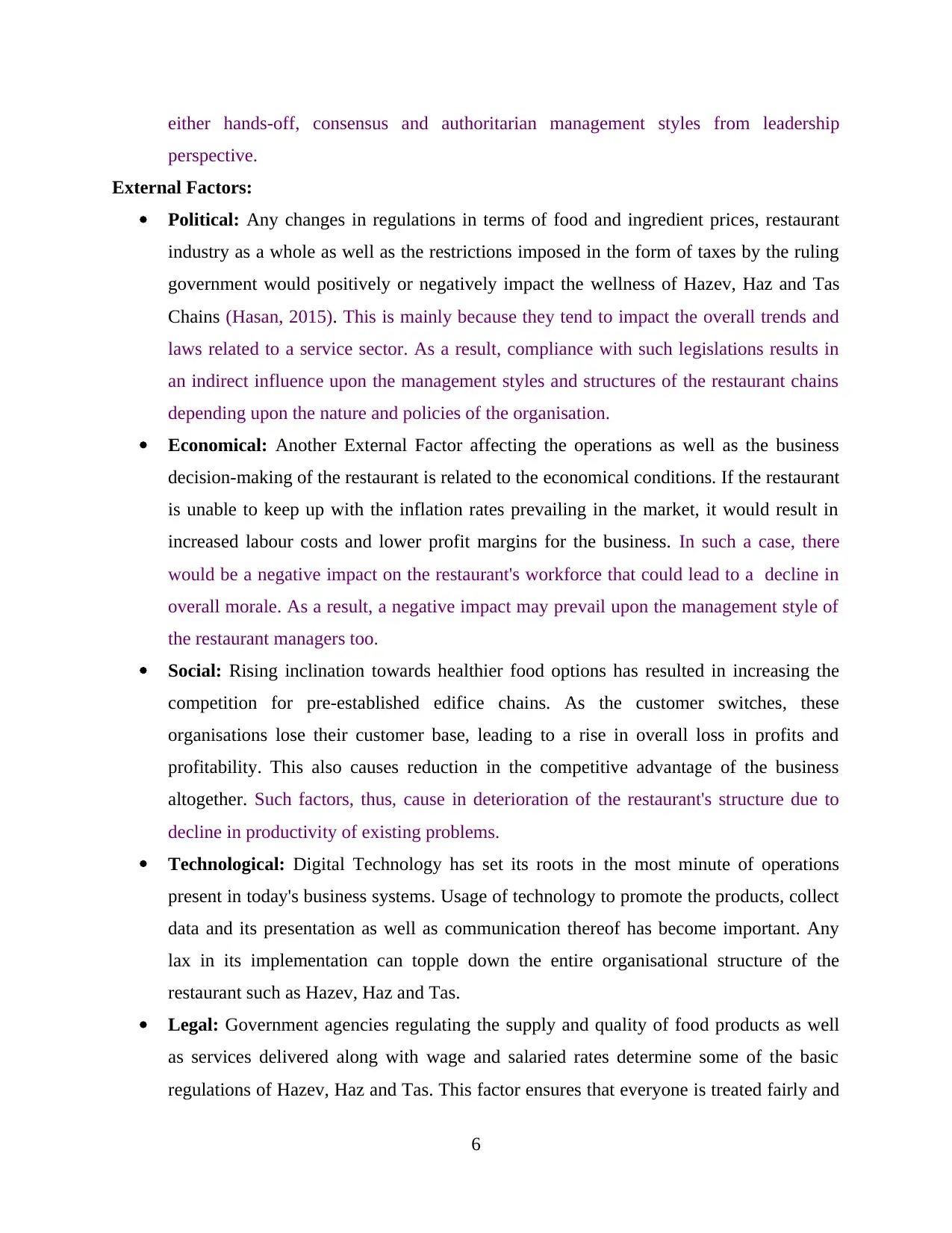
either hands-off, consensus and authoritarian management styles from leadership
perspective.
External Factors:
Political: Any changes in regulations in terms of food and ingredient prices, restaurant
industry as a whole as well as the restrictions imposed in the form of taxes by the ruling
government would positively or negatively impact the wellness of Hazev, Haz and Tas
Chains (Hasan, 2015). This is mainly because they tend to impact the overall trends and
laws related to a service sector. As a result, compliance with such legislations results in
an indirect influence upon the management styles and structures of the restaurant chains
depending upon the nature and policies of the organisation.
Economical: Another External Factor affecting the operations as well as the business
decision-making of the restaurant is related to the economical conditions. If the restaurant
is unable to keep up with the inflation rates prevailing in the market, it would result in
increased labour costs and lower profit margins for the business. In such a case, there
would be a negative impact on the restaurant's workforce that could lead to a decline in
overall morale. As a result, a negative impact may prevail upon the management style of
the restaurant managers too.
Social: Rising inclination towards healthier food options has resulted in increasing the
competition for pre-established edifice chains. As the customer switches, these
organisations lose their customer base, leading to a rise in overall loss in profits and
profitability. This also causes reduction in the competitive advantage of the business
altogether. Such factors, thus, cause in deterioration of the restaurant's structure due to
decline in productivity of existing problems.
Technological: Digital Technology has set its roots in the most minute of operations
present in today's business systems. Usage of technology to promote the products, collect
data and its presentation as well as communication thereof has become important. Any
lax in its implementation can topple down the entire organisational structure of the
restaurant such as Hazev, Haz and Tas.
Legal: Government agencies regulating the supply and quality of food products as well
as services delivered along with wage and salaried rates determine some of the basic
regulations of Hazev, Haz and Tas. This factor ensures that everyone is treated fairly and
6
perspective.
External Factors:
Political: Any changes in regulations in terms of food and ingredient prices, restaurant
industry as a whole as well as the restrictions imposed in the form of taxes by the ruling
government would positively or negatively impact the wellness of Hazev, Haz and Tas
Chains (Hasan, 2015). This is mainly because they tend to impact the overall trends and
laws related to a service sector. As a result, compliance with such legislations results in
an indirect influence upon the management styles and structures of the restaurant chains
depending upon the nature and policies of the organisation.
Economical: Another External Factor affecting the operations as well as the business
decision-making of the restaurant is related to the economical conditions. If the restaurant
is unable to keep up with the inflation rates prevailing in the market, it would result in
increased labour costs and lower profit margins for the business. In such a case, there
would be a negative impact on the restaurant's workforce that could lead to a decline in
overall morale. As a result, a negative impact may prevail upon the management style of
the restaurant managers too.
Social: Rising inclination towards healthier food options has resulted in increasing the
competition for pre-established edifice chains. As the customer switches, these
organisations lose their customer base, leading to a rise in overall loss in profits and
profitability. This also causes reduction in the competitive advantage of the business
altogether. Such factors, thus, cause in deterioration of the restaurant's structure due to
decline in productivity of existing problems.
Technological: Digital Technology has set its roots in the most minute of operations
present in today's business systems. Usage of technology to promote the products, collect
data and its presentation as well as communication thereof has become important. Any
lax in its implementation can topple down the entire organisational structure of the
restaurant such as Hazev, Haz and Tas.
Legal: Government agencies regulating the supply and quality of food products as well
as services delivered along with wage and salaried rates determine some of the basic
regulations of Hazev, Haz and Tas. This factor ensures that everyone is treated fairly and
6
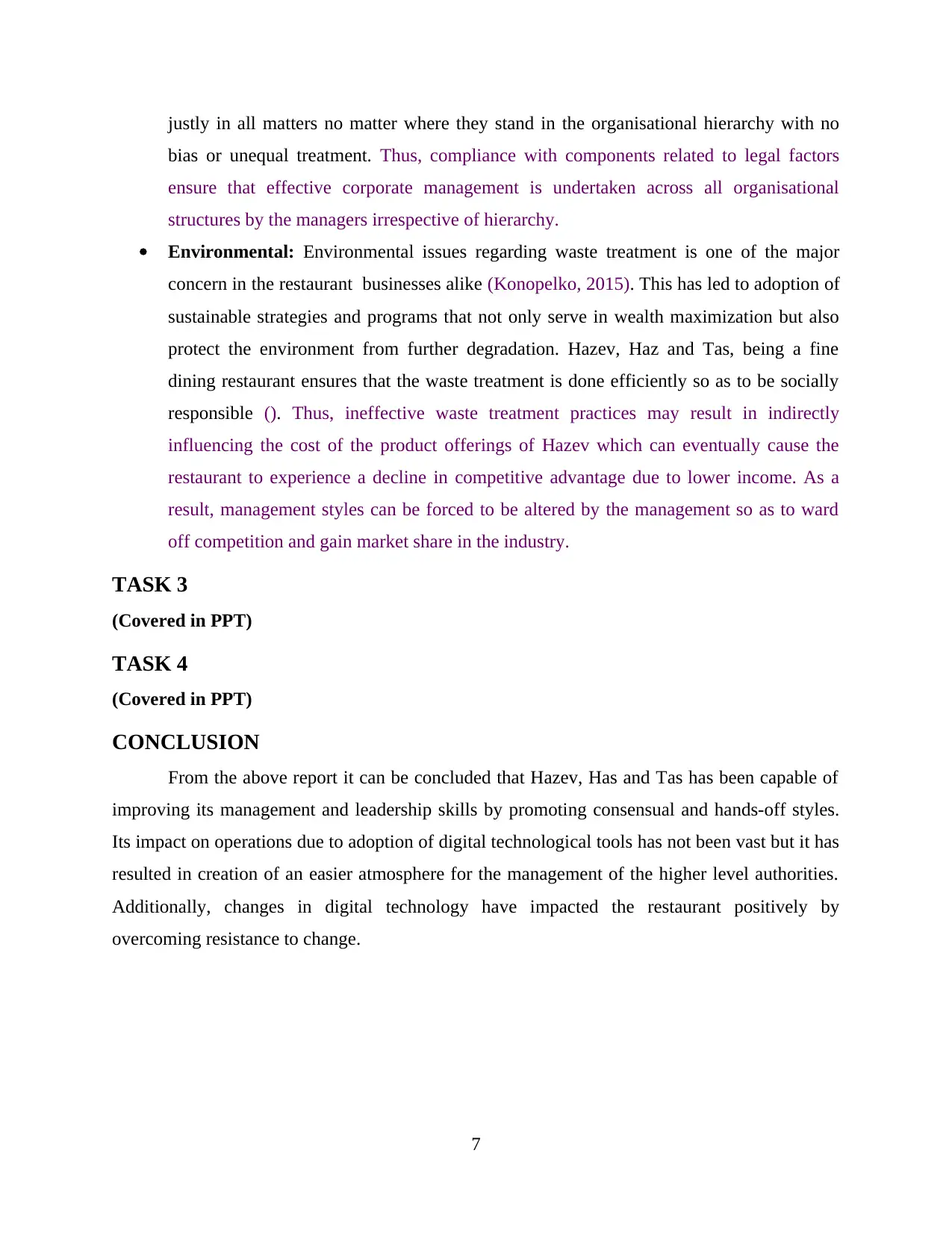
justly in all matters no matter where they stand in the organisational hierarchy with no
bias or unequal treatment. Thus, compliance with components related to legal factors
ensure that effective corporate management is undertaken across all organisational
structures by the managers irrespective of hierarchy.
Environmental: Environmental issues regarding waste treatment is one of the major
concern in the restaurant businesses alike (Konopelko, 2015). This has led to adoption of
sustainable strategies and programs that not only serve in wealth maximization but also
protect the environment from further degradation. Hazev, Haz and Tas, being a fine
dining restaurant ensures that the waste treatment is done efficiently so as to be socially
responsible (). Thus, ineffective waste treatment practices may result in indirectly
influencing the cost of the product offerings of Hazev which can eventually cause the
restaurant to experience a decline in competitive advantage due to lower income. As a
result, management styles can be forced to be altered by the management so as to ward
off competition and gain market share in the industry.
TASK 3
(Covered in PPT)
TASK 4
(Covered in PPT)
CONCLUSION
From the above report it can be concluded that Hazev, Has and Tas has been capable of
improving its management and leadership skills by promoting consensual and hands-off styles.
Its impact on operations due to adoption of digital technological tools has not been vast but it has
resulted in creation of an easier atmosphere for the management of the higher level authorities.
Additionally, changes in digital technology have impacted the restaurant positively by
overcoming resistance to change.
7
bias or unequal treatment. Thus, compliance with components related to legal factors
ensure that effective corporate management is undertaken across all organisational
structures by the managers irrespective of hierarchy.
Environmental: Environmental issues regarding waste treatment is one of the major
concern in the restaurant businesses alike (Konopelko, 2015). This has led to adoption of
sustainable strategies and programs that not only serve in wealth maximization but also
protect the environment from further degradation. Hazev, Haz and Tas, being a fine
dining restaurant ensures that the waste treatment is done efficiently so as to be socially
responsible (). Thus, ineffective waste treatment practices may result in indirectly
influencing the cost of the product offerings of Hazev which can eventually cause the
restaurant to experience a decline in competitive advantage due to lower income. As a
result, management styles can be forced to be altered by the management so as to ward
off competition and gain market share in the industry.
TASK 3
(Covered in PPT)
TASK 4
(Covered in PPT)
CONCLUSION
From the above report it can be concluded that Hazev, Has and Tas has been capable of
improving its management and leadership skills by promoting consensual and hands-off styles.
Its impact on operations due to adoption of digital technological tools has not been vast but it has
resulted in creation of an easier atmosphere for the management of the higher level authorities.
Additionally, changes in digital technology have impacted the restaurant positively by
overcoming resistance to change.
7
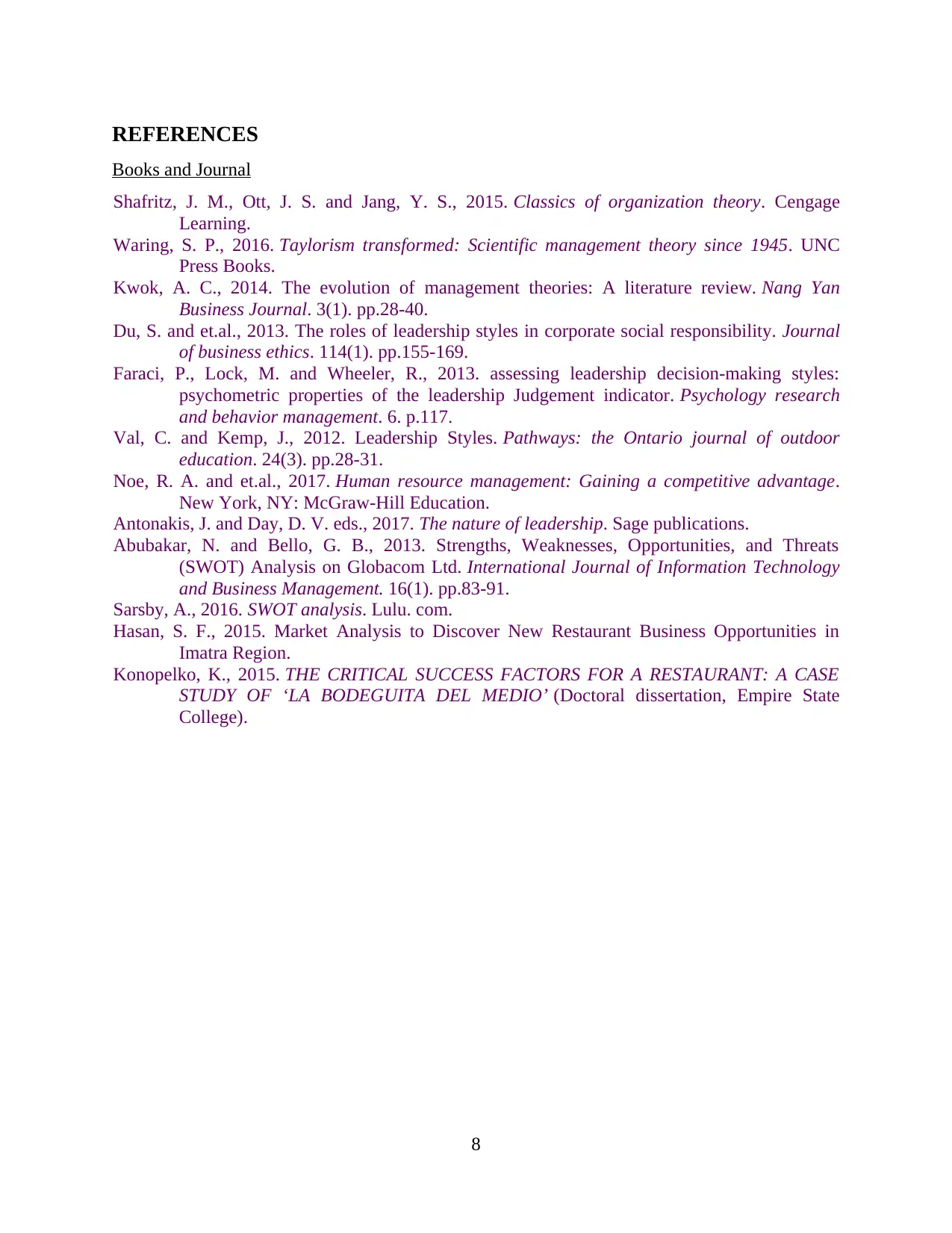
REFERENCES
Books and Journal
Shafritz, J. M., Ott, J. S. and Jang, Y. S., 2015. Classics of organization theory. Cengage
Learning.
Waring, S. P., 2016. Taylorism transformed: Scientific management theory since 1945. UNC
Press Books.
Kwok, A. C., 2014. The evolution of management theories: A literature review. Nang Yan
Business Journal. 3(1). pp.28-40.
Du, S. and et.al., 2013. The roles of leadership styles in corporate social responsibility. Journal
of business ethics. 114(1). pp.155-169.
Faraci, P., Lock, M. and Wheeler, R., 2013. assessing leadership decision-making styles:
psychometric properties of the leadership Judgement indicator. Psychology research
and behavior management. 6. p.117.
Val, C. and Kemp, J., 2012. Leadership Styles. Pathways: the Ontario journal of outdoor
education. 24(3). pp.28-31.
Noe, R. A. and et.al., 2017. Human resource management: Gaining a competitive advantage.
New York, NY: McGraw-Hill Education.
Antonakis, J. and Day, D. V. eds., 2017. The nature of leadership. Sage publications.
Abubakar, N. and Bello, G. B., 2013. Strengths, Weaknesses, Opportunities, and Threats
(SWOT) Analysis on Globacom Ltd. International Journal of Information Technology
and Business Management. 16(1). pp.83-91.
Sarsby, A., 2016. SWOT analysis. Lulu. com.
Hasan, S. F., 2015. Market Analysis to Discover New Restaurant Business Opportunities in
Imatra Region.
Konopelko, K., 2015. THE CRITICAL SUCCESS FACTORS FOR A RESTAURANT: A CASE
STUDY OF ‘LA BODEGUITA DEL MEDIO’ (Doctoral dissertation, Empire State
College).
8
Books and Journal
Shafritz, J. M., Ott, J. S. and Jang, Y. S., 2015. Classics of organization theory. Cengage
Learning.
Waring, S. P., 2016. Taylorism transformed: Scientific management theory since 1945. UNC
Press Books.
Kwok, A. C., 2014. The evolution of management theories: A literature review. Nang Yan
Business Journal. 3(1). pp.28-40.
Du, S. and et.al., 2013. The roles of leadership styles in corporate social responsibility. Journal
of business ethics. 114(1). pp.155-169.
Faraci, P., Lock, M. and Wheeler, R., 2013. assessing leadership decision-making styles:
psychometric properties of the leadership Judgement indicator. Psychology research
and behavior management. 6. p.117.
Val, C. and Kemp, J., 2012. Leadership Styles. Pathways: the Ontario journal of outdoor
education. 24(3). pp.28-31.
Noe, R. A. and et.al., 2017. Human resource management: Gaining a competitive advantage.
New York, NY: McGraw-Hill Education.
Antonakis, J. and Day, D. V. eds., 2017. The nature of leadership. Sage publications.
Abubakar, N. and Bello, G. B., 2013. Strengths, Weaknesses, Opportunities, and Threats
(SWOT) Analysis on Globacom Ltd. International Journal of Information Technology
and Business Management. 16(1). pp.83-91.
Sarsby, A., 2016. SWOT analysis. Lulu. com.
Hasan, S. F., 2015. Market Analysis to Discover New Restaurant Business Opportunities in
Imatra Region.
Konopelko, K., 2015. THE CRITICAL SUCCESS FACTORS FOR A RESTAURANT: A CASE
STUDY OF ‘LA BODEGUITA DEL MEDIO’ (Doctoral dissertation, Empire State
College).
8
1 out of 10
Related Documents
Your All-in-One AI-Powered Toolkit for Academic Success.
+13062052269
info@desklib.com
Available 24*7 on WhatsApp / Email
![[object Object]](/_next/static/media/star-bottom.7253800d.svg)
Unlock your academic potential
© 2024 | Zucol Services PVT LTD | All rights reserved.





